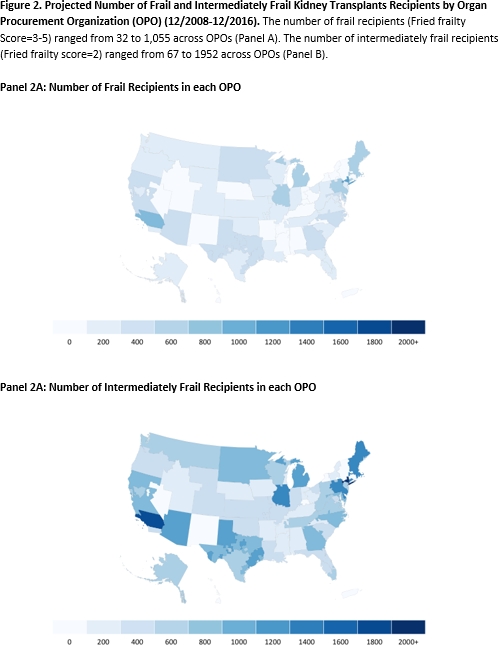Prevalence of Frailty among Kidney Transplant Recipients in the United States
A. Thomas,1 A. Shaffer,1 H. Ying,1 S. Norman,2 D. Segev,1 M. McAdams-DeMarco.1
1JHU, Baltimore
2University of Michigan, Ann Arbor.
Meeting: 2018 American Transplant Congress
Abstract number: 129
Keywords: Age factors, Elderly patients, High-risk, Kidney transplantation
Session Information
Session Name: Concurrent Session: Kidney Psychosocial - 1
Session Type: Concurrent Session
Date: Sunday, June 3, 2018
Session Time: 4:30pm-6:00pm
 Presentation Time: 5:30pm-5:42pm
Presentation Time: 5:30pm-5:42pm
Location: Room 210
Frailty, a measure of physiologic reserve, increases the risk of delayed graft function, longer length of stay, early hospital readmission, immunosuppression intolerance, and mortality among kidney transplant (KT) recipients. Despite its clinical importance in predicting KT outcomes, there are no national estimates of the prevalence or geographic distribution of frailty among US KT recipients.
METHODS: Frailty (Fried phenotype) was prospectively measured in 1,065 KT recipients (12/2008-12/2016) in our multi-center cohort. Using SRTR data on 126,376 KT recipients, we projected the prevalence of frailty and intermediate frailty using predictive mean matching to multiply impute frailty scores, accounting for recipient, donor, transplant, and post-transplant factors.
RESULTS: In our multi-center cohort, the prevalence of frailty and intermediate frailty were 18.4% and 30.0%, respectively, among deceased-donor KT (DDKT) recipients and 14.5% and 28.1%, respectively, among living-donor KT (LDKT) recipients. Projected nationally, the prevalence of frailty and intermediate frailty were 18.0% (95% CI: 14.7-21.3%) and 29.9% (95% CI: 27.5-32.2%), respectively, among DDKT recipients and 12.5% (95% CI: 10.8-14.3%) and 28.4% (95% CI: 23.8-33.0%), respectively, among LDKT recipients. Frailty prevalence varied by geography (p<0.001) (Figures 1 and 2).
CONCLUSION: We project that nearly 20% of KTs 2000-2016 were performed with frail recipients; however, these recipients and their providers were likely not aware of their higher risk for adverse post-KT outcomes. Given its prevalence, transplant programs should consider assessing frailty during KT evaluation to improve informed consent and identify candidates for pre-KT interventions.
CITATION INFORMATION: Thomas A., Shaffer A., Ying H., Norman S., Segev D., McAdams-DeMarco M. Prevalence of Frailty among Kidney Transplant Recipients in the United States Am J Transplant. 2017;17 (suppl 3).
To cite this abstract in AMA style:
Thomas A, Shaffer A, Ying H, Norman S, Segev D, McAdams-DeMarco M. Prevalence of Frailty among Kidney Transplant Recipients in the United States [abstract]. https://atcmeetingabstracts.com/abstract/prevalence-of-frailty-among-kidney-transplant-recipients-in-the-united-states/. Accessed January 3, 2026.« Back to 2018 American Transplant Congress


